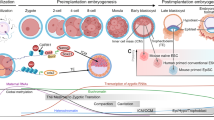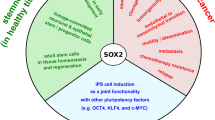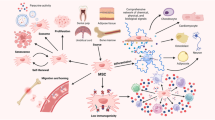Key Points
-
Embryonic and adult tissue stem cells are characterized by their ability to self-renew and to differentiate into daughter cells, which in adult tissue stem cells is often achieved by asymmetric divisions.
-
MicroRNAs (miRNAs) are 20–25-nucleotide (nt)-long non-coding RNAs that bind to the 3′ untranslated region of target mRNAs via imperfect match to repress their translation and stability.
-
miRNAs fine-tune self-renewal and differentiation pathways of stem cells by regulating the intracellular levels of the key protein factors that are involved in these processes. It is now clear that a number of miRNAs that are involved in stem cell processes are co-expressed as clusters and can function as 'master regulators' of stem cell processes.
-
miRNAs and the transcriptional machinery form an integral network that regulates stem cell processes.
-
In addition to miRNA, there are two other types of small RNAs: endogenous small interfering RNAs (endo-siRNAs) and Piwi-interacting RNAs (piRNAs). Their presence and function in stem cells is not known.
-
The recent advent of next generation sequencing technologies has increased our ability to identify new miRNAs and other small RNAs in various tissues.
Abstract
The hallmark of a stem cell is its ability to self-renew and to produce numerous differentiated cells. This unique property is controlled by dynamic interplays between extrinsic signalling, epigenetic, transcriptional and post-transcriptional regulations. Recent research indicates that microRNAs (miRNAs) have an important role in regulating stem cell self-renewal and differentiation by repressing the translation of selected mRNAs in stem cells and differentiating daughter cells. Such a role has been shown in embryonic stem cells, germline stem cells and various somatic tissue stem cells. These findings reveal a new dimension of gene regulation in controlling stem cell fate and behaviour.
This is a preview of subscription content, access via your institution
Access options
Subscribe to this journal
Receive 12 print issues and online access
$189.00 per year
only $15.75 per issue
Buy this article
- Purchase on Springer Link
- Instant access to full article PDF
Prices may be subject to local taxes which are calculated during checkout


Similar content being viewed by others
References
Sell, S. Stem Cells Handbook (Humana, Totowa, New Jersey, 2003).
Lin, H. Cell biology of stem cells: an enigma of asymmetry and self-renewal. J. Cell Biol. 180, 257–260 (2008).
Lin, H. The stem-cell niche theory: lessons from flies. Nature Rev. Genet. 3, 931–940 (2002).
Blakaj, A. & Lin, H. Piecing together the mosaic of early mammalian development through microRNAs. J. Biol. Chem. 283, 9505–9508 (2008).
Rana, T. M. Illuminating the silence: understanding the structure and function of small RNAs. Nature Rev. Mol. Cell Biol. 8, 23–36 (2007).
Vasudevan, S., Tong, Y. & Steitz, J. A. Switching from repression to activation: microRNAs can up-regulate translation. Science 318, 1931–1934 (2007). Provides the first evidence for translational activation by miRNAs.
Okamura, K., Hagen, J. W., Duan, H., Tyler, D. M. & Lai, E. C. The mirtron pathway generates microRNA-class regulatory RNAs in Drosophila. Cell 130, 89–100 (2007).
Ruby, J. G., Jan, C. H. & Bartel, D. P. Intronic microRNA precursors that bypass Drosha processing. Nature 448, 83–86 (2007).
Babiarz, J. E., Ruby, J. G., Wang, Y., Bartel, D. P. & Blelloch, R. Mouse ES cells express endogenous shRNAs, siRNAs, and other Microprocessor-independent, Dicer-dependent small RNAs. Genes Dev. 22, 2773–2785 (2008). References 7–9 introduce new pathways for miRNA biogenesis. Reference 9 also shows that endogenous siRNAs are expressed in mouse ES cells.
Okamura, K. & Lai, E. C. Endogenous small interfering RNAs in animals. Nature Rev. Mol. Cell Biol. 9, 673–678 (2008).
Lin, H. piRNAs in the germ line. Science 316, 397 (2007).
Yin, H. & Lin, H. An epigenetic activation role of Piwi and a Piwi-associated piRNA in Drosophila melanogaster. Nature 450, 304–308 (2007). Provides the first evidence that piRNAs mediate epigenetic activation.
Houbaviy, H. B., Murray, M. F. & Sharp, P. A. Embryonic stem cell-specific microRNAs. Dev. Cell 5, 351–358 (2003). Provides the earliest evidence for the existence of ES cell-specific miRNAs and also evidence that self-renewing and differentiating ES cells have distinct miRNAs.
Tomari, Y. & Zamore, P. D. Perspective: machines for RNAi. Genes Dev. 19, 517–529 (2005).
Bernstein, E. et al. Dicer is essential for mouse development. Nature Genet. 35, 215–217 (2003).
Kanellopoulou, C. et al. Dicer-deficient mouse embryonic stem cells are defective in differentiation and centromeric silencing. Genes Dev. 19, 489–501 (2005). References 15 and 16 describe the biological function of Dicer in mouse embryonic stem cells.
Calabrese, J. M., Seila, A. C., Yeo, G. W. & Sharp, P. A. RNA sequence analysis defines Dicer's role in mouse embryonic stem cells. Proc. Natl Acad. Sci. USA 104, 18097–18102 (2007).
Wang, Y., Medvid, R., Melton, C., Jaenisch, R. & Blelloch, R. DGCR8 is essential for microRNA biogenesis and silencing of embryonic stem cell self-renewal. Nature Genet. 39, 380–385 (2007). Shows the specific requirement of the miRNA pathway for stem cell differentiation and cell cycle control.
Suh, M. R. et al. Human embryonic stem cells express a unique set of microRNAs. Dev. Biol. 270, 488–498 (2004). This reference, along with reference 10, provides evidence for distinct miRNA signatures for self-renewing and differentiating stem cells.
Morin, R. D. et al. Application of massively parallel sequencing to microRNA profiling and discovery in human embryonic stem cells. Genome Res. 18, 610–621 (2008).
Neilson, J. R., Zheng, G. X., Burge, C. B. & Sharp, P. A. Dynamic regulation of miRNA expression in ordered stages of cellular development. Genes Dev. 21, 578–589 (2007).
Nakano, M. et al. Plant MPSS databases: signature-based transcriptional resources for analyses of mRNA and small RNA. Nucleic Acids Res. 34, D731–D735 (2006).
Margulies, M. et al. Genome sequencing in microfabricated high-density picolitre reactors. Nature 437, 376–380 (2005).
Hafner, M. et al. Identification of microRNAs and other small regulatory RNAs using cDNA library sequencing. Methods 44, 3–12 (2008).
Hayashi, K. et al. MicroRNA biogenesis is required for mouse primordial germ cell development and spermatogenesis. PLoS ONE 3, e1738 (2008).
Singh, S. K., Kagalwala, M. N., Parker-Thornburg, J., Adams, H. & Majumder, S. REST maintains self-renewal and pluripotency of embryonic stem cells. Nature 453, 223–227 (2008).
Tay, Y., Zhang, J., Thomson, A. M., Lim, B. & Rigoutsos, I. MicroRNAs to Nanog, Oct4 and Sox2 coding regions modulate embryonic stem cell differentiation. Nature 455, 1124–1128 (2008). Shows, for the first time, that miRNAs can also target coding regions instead of the 3′ UTR, and regulate translation of cognate mRNAs.
Marson, A. et al. Connecting microRNA genes to the core transcriptional regulatory circuitry of embryonic stem cells. Cell 134, 521–533 (2008). Shows, on a global scale, that key ES cell-specific transcription factors directly associate with promoter regions of ES cell-specific miRNAs, and thereby provides a mechanistic link between transcription factors and miRNA-dependent ES cell regulation.
Benetti, R. et al. A mammalian microRNA cluster controls DNA methylation and telomere recombination via Rbl2-dependent regulation of DNA methyltransferases. Nature Struct. Biol. 15, 268–279 (2008).
Sinkkonen, L. et al. MicroRNAs control de novo DNA methylation through regulation of transcriptional repressors in mouse embryonic stem cells. Nature Struct. Biol. 15, 259–267 (2008).
Yu, J. et al. Induced pluripotent stem cell lines derived from human somatic cells. Science 318, 1917–1920 (2007).
Viswanathan, S. R., Daley, G. Q. & Gregory, R. I. Selective blockade of microRNA processing by Lin28. Science 320, 97–100 (2008).
Rybak, A. et al. A feedback loop comprising lin-28 and let-7 controls pre-let-7 maturation during neural stem-cell commitment. Nature Cell Biol. 10, 987–993 (2008).
Newman, M. A., Thomson, J. M. & Hammond, S. M. Lin-28 interaction with the Let-7 precursor loop mediates regulated microRNA processing. RNA 14, 1539–1549 (2008).
Georgantas, R. W. 3rd et al. CD34+ hematopoietic stem-progenitor cell microRNA expression and function: a circuit diagram of differentiation control. Proc. Natl Acad. Sci. USA 104, 2750–2755 (2007).
Chen, C. Z., Li, L., Lodish, H. F. & Bartel, D. P. MicroRNAs modulate hematopoietic lineage differentiation. Science 303, 83–86 (2004). Provides the first evidence that miRNAs are involved in the differentiation of an adult stem cell lineage.
Bruchova, H., Yoon, D., Agarwal, A. M., Mendell, J. & Prchal, J. T. Regulated expression of microRNAs in normal and polycythemia vera erythropoiesis. Exp. Hematol. 35, 1657–1667 (2007).
Wang, Q. et al. MicroRNA miR-24 inhibits erythropoiesis by targeting activin type I receptor ALK4. Blood 111, 588–595 (2008).
Felli, N. et al. MicroRNAs 221 and 222 inhibit normal erythropoiesis and erythroleukemic cell growth via kit receptor down-modulation. Proc. Natl Acad. Sci. USA 102, 18081–18086 (2005).
Fontana, L. et al. MicroRNAs 17-5p–20a–106a control monocytopoiesis through AML1 targeting and M-CSF receptor upregulation. Nature Cell Biol. 9, 775–787 (2007).
Zhou, B., Wang, S., Mayr, C., Bartel, D. P. & Lodish, H. F. miR-150, a microRNA expressed in mature B and T cells, blocks early B cell development when expressed prematurely. Proc. Natl Acad. Sci. USA 104, 7080–7085 (2007).
Dore, L. C. et al. A GATA-1-regulated microRNA locus essential for erythropoiesis. Proc. Natl Acad. Sci. USA 105, 3333–3338 (2008).
Rosa, A. et al. The interplay between the master transcription factor PU.1 and miR-424 regulates human monocyte/macrophage differentiation. Proc. Natl Acad. Sci. USA 104, 19849–19854 (2007).
Buckingham, M. Myogenic progenitor cells and skeletal myogenesis in vertebrates. Curr. Opin. Genet. Dev. 16, 525–532 (2006).
Chen, J. F. et al. The role of microRNA-1 and microRNA-133 in skeletal muscle proliferation and differentiation. Nature Genet. 38, 228–233 (2006).
Anderson, C., Catoe, H. & Werner, R. MIR-206 regulates connexin43 expression during skeletal muscle development. Nucleic Acids Res. 34, 5863–5871 (2006).
McCarthy, J. J. MicroRNA-206: the skeletal muscle-specific myomiR. Biochim. Biophys. Acta 1779, 682–691 (2008).
Ivey, K. N. et al. MicroRNA regulation of cell lineages in mouse and human embryonic stem cells. Cell Stem Cell 2, 219–229 (2008).
Wong, C. F. & Tellam, R. L. MicroRNA-26a targets the histone methyltransferase enhancer of zeste homolog 2 during myogenesis. J. Biol. Chem. 283, 9836–9843 (2008).
Caretti, G., Di Padova, M., Micales, B., Lyons, G. E. & Sartorelli, V. The polycomb Ezh2 methyltransferase regulates muscle gene expression and skeletal muscle differentiation. Genes Dev. 18, 2627–2638 (2004).
Zhao, Y., Samal, E. & Srivastava, D. Serum response factor regulates a muscle-specific microRNA that targets Hand2 during cardiogenesis. Nature 436, 214–220 (2005).
Rao, P. K., Kumar, R. M., Farkhondeh, M., Baskerville, S. & Lodish, H. F. Myogenic factors that regulate expression of muscle-specific microRNAs. Proc. Natl Acad. Sci. USA 103, 8721–8726 (2006).
Sun, Q. et al. Transforming growth factor-β-regulated miR-24 promotes skeletal muscle differentiation. Nucleic Acids Res. 36, 2690–2699 (2008).
Shi, Y., Sun, G., Zhao, C. & Stewart, R. Neural stem cell self-renewal. Crit. Rev. Oncol. Hematol. 65, 43–53 (2008).
Smirnova, L. et al. Regulation of miRNA expression during neural cell specification. Eur. J. Neurosci. 21, 1469–1477 (2005).
Krichevsky, A. M., Sonntag, K. C., Isacson, O. & Kosik, K. S. Specific microRNAs modulate embryonic stem cell-derived neurogenesis. Stem Cells 24, 857–864 (2006).
Visvanathan, J., Lee, S., Lee, B., Lee, J. W. & Lee, S. K. The microRNA miR-124 antagonizes the anti-neural REST/SCP1 pathway during embryonic CNS development. Genes Dev. 21, 744–749 (2007).
Yeo, M. et al. Small CTD phosphatases function in silencing neuronal gene expression. Science 307, 596–600 (2005).
Heino, T. J. & Hentunen, T. A. Differentiation of osteoblasts and osteocytes from mesenchymal stem cells. Curr. Stem Cell Res. Ther. 3, 131–145 (2008).
Mizuno, Y. et al. miR-125b inhibits osteoblastic differentiation by down-regulation of cell proliferation. Biochem. Biophys. Res. Commun. 368, 267–272 (2008).
Luzi, E. et al. Osteogenic differentiation of human adipose tissue-derived stem cells is modulated by the miR-26a targeting of the SMAD1 transcription factor. J. Bone Miner. Res. 23, 287–295 (2008).
Andl, T. et al. The miRNA-processing enzyme dicer is essential for the morphogenesis and maintenance of hair follicles. Curr. Biol. 16, 1041–1049 (2006).
Yi, R. et al. Morphogenesis in skin is governed by discrete sets of differentially expressed microRNAs. Nature Genet. 38, 356–362 (2006).
Yi, R., Poy, M. N., Stoffel, M. & Fuchs, E. A skin microRNA promotes differentiation by repressing 'stemness'. Nature 452, 225–229 (2008).
Megosh, H. B., Cox, D. N., Campbell, C. & Lin, H. The role of PIWI and the miRNA machinery in Drosophila germline determination. Curr. Biol. 16, 1884–1894 (2006).
Park, J. K., Liu, X., Strauss, T. J., McKearin, D. M. & Liu, Q. The miRNA pathway intrinsically controls self-renewal of Drosophila germline stem cells. Curr. Biol. 17, 533–538 (2007).
Forstemann, K. et al. Normal microRNA maturation and germ-line stem cell maintenance requires Loquacious, a double-stranded RNA-binding domain protein. PLoS Biol. 3, e236 (2005).
Hatfield, S. D. et al. Stem cell division is regulated by the microRNA pathway. Nature 435, 974–978 (2005).
Knight, S. W. & Bass, B. L. A role for the RNase III enzyme DCR-1 in RNA interference and germ line development in Caenorhabditis elegans. Science 293, 2269–2271 (2001).
Beyret, E. & Lin, H. in MicroRNAs — from Basic Science to Disease Biology (ed. Appasani, K.) 497–511 (Cambridge Univ. Press, New York, 2008).
Palakodeti, D., Smielewska, M., Lu, Y. C., Yeo, G. W. & Graveley, B. R. The PIWI proteins SMEDWI-2 and SMEDWI-3 are required for stem cell function and piRNA expression in planarians. RNA 14, 1174–1186 (2008).
Acknowledgements
We thank members of the Lin laboratory for their valuable comments on the manuscript. We apologize to those whose works are not cited here owing to space limitations. The stem cell work done in the Lin laboratory is supported by National Institutes of Health Grants HD33760, HD37760S1 and HD42042, the Connecticut Stem Cell Research Fund, the G. Harold and Leila Mathers Foundation and the Stem Cell Research Foundation.
Author information
Authors and Affiliations
Corresponding author
Related links
Related links
DATABASES
FURTHER INFORMATION
Glossary
- Blastocyst
-
An early stage of embryonic development at which cells begin to commit to two developmental lineages: the inner cell mass, which gives rise to the fetus, and the trophoblast, which gives rise to fetal support tissues, such as the placenta and the umbilical cord.
- Niche
-
The natural anatomical microenvironment that supports stem cell behaviour.
- Spliceosome
-
A ribonucleoprotein (RNP) complex that is involved in splicing of nuclear pre-mRNA. It is composed of five small nuclear (sn) RNPs and more than 50 non-snRNPs, which recognize and assemble on exon–intron boundaries to catalyse intron processing of the pre-mRNA.
- Piwi
-
An Argonaute or Piwi protein family member in Drosophila melanogaster that is required for germline stem cell self-renewal and also binds to ∼25 nucleotide small RNAs. Piwi is the founding member that was used to define the protein family.
- Transposon
-
A mobile genetic element that can relocate within the genome of its host. An autonomous transposon encodes a transposase protein that catalyses its excision and reintegration in the genome, and can therefore direct its own transposition.
- Gap junction
-
An intercellular connection that directly connects cytoplasm of two cells so that exchange of molecules and ions can occur freely.
- Neoblast
-
An undifferentiated cell in annelids that proliferates to produce differentiated cells at the sites of repair.
Rights and permissions
About this article
Cite this article
Gangaraju, V., Lin, H. MicroRNAs: key regulators of stem cells. Nat Rev Mol Cell Biol 10, 116–125 (2009). https://doi.org/10.1038/nrm2621
Issue Date:
DOI: https://doi.org/10.1038/nrm2621
This article is cited by
-
Insight into microRNAs’ involvement in hematopoiesis: current standing point of findings
Stem Cell Research & Therapy (2023)
-
MicroRNA therapeutic targets in neonatal hypoxic–ischemic brain injury: a narrative review
Pediatric Research (2023)
-
MicroRNAs Function in Dental Stem Cells as a Promising Biomarker and Therapeutic Target for Dental Diseases
Molecular Diagnosis & Therapy (2023)
-
Systemic proteomics and miRNA profile analysis of exosomes derived from human pluripotent stem cells
Stem Cell Research & Therapy (2022)
-
Plasma Exo-miRNAs Correlated with AD-Related Factors of Chinese Individuals Involved in Aβ Accumulation and Cognition Decline
Molecular Neurobiology (2022)



